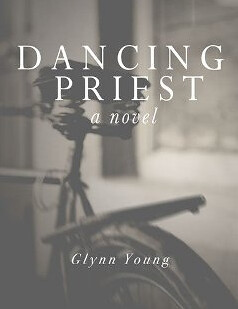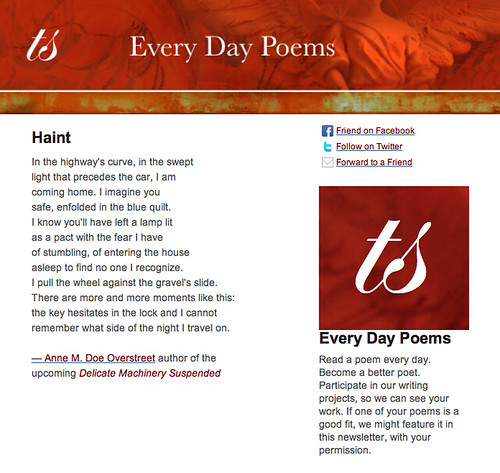Glynn Young, a contributing editor here at Tweetspeak, is the author of a newly published novel, Dancing Priest. A professional writer with a background in journalism, speechwriting, and public relations and marketing, Glynn began blogging in 2009. It was at Faith, Fiction, Friends, where Glynn posted a poem for the first time, that I first found his work; since then, he’s become a friend whose writing trajectory I’ve watched with interest and admiration. To learn about Glynn’s writing life generally, see my interview at The High Calling: A Man of Many Good Words.
MD: You’ve written* that your first and every subsequent hearing of the song Luna Rossa [translated as “Blushing Moon” or “Red Moon”] evoked an image of a priest dancing on a beach, and that it was this image that gave way to your story idea. The song’s lyrics address “playing the part of love” and include the lines “. . . forgive me, Luna Rossa / For the vows I made tonight that are untrue. . . .” Given a priest as central character, those lyrics hold double meaning, making your story line seem especially promising for its inherent tensions; we might even say it was “received” inspiration. How conscious were you of the meaning of the lyrics while writing the novel?
GY: I don’t speak or read Italian. I had no idea what the lyrics meant. And I can’t explain why the song evoked that image. It just did. The priest was never [in my mind] a Catholic priest. For some reason, I knew he was Episcopal or Anglican.
MD: What about that song accounts for its continued strong hold on you?
GY: I think it’s the beat. I probably should mention that I love to dance. My wife gets embarrassed when we dance together. She says, “You don’t dance; you perform.”
MD: Does music have a role in the novel or otherwise help in some way to frame the story?
GY: In two scenes, one early and one late. The early scene involves the two lead characters, Michael Kent and Sarah Hughes, doing a tango. The later scene involves a youth group at the Church to which Michael is assigned; the former discover they have a dancing priest and name him that.
MD: Who is the novel’s audience? Did you specifically and consciously write for that audience?
GY: I didn’t write with an audience in mind. I wrote the entire novel, and a lot more, in my head over a three-year period. I didn’t really think about who was going to read it; for the three years I thought it was just a story in my head. After I started the writing process, I thought about audience, but by then the story itself was in control.
MD: What is the significance of the locale of your novel? Why the United Kingdom?
GY: The story is told in six parts; the first and third are in the UK, the second in Greece, and the last three in California. I’m not exactly sure when it happened but, at some point early on, my dancing priest on a beach in Italy became a theology student in Scotland. The story moved to the UK because the priest was Anglican.
MD: Interestingly, as you note, you always envisioned the priest Michael as Anglican (Episcopalian in America), a faith, unlike Catholicism, that allows priests to be married and so, for purposes of your story, allows for the possibility of flesh-and-blood romance. How deliberate was your choice of faith for the protagonist?
GY: It was very deliberate. I knew, even when the novel was all in my head, that this was going to be about a romance, a romance that moves forward in spite of a gap of shared belief. It can go only so far before it breaks down.
MD: To what extent, if at all, does your own personal faith journey echo in your conception and realization of the story and its main characters?
GY: The story of Sarah’s journey toward faith is based almost entirely on my own, including many of the specific details.
MD: You give several interesting twists to Michael, making him English-born but raised by Scottish guardians, a man studying for the priesthood at a university not a seminary, and a contender for an Olympic cycling team. Any one of these aspects would seem to offer myriad possibilities for character and story development; yet, you employ all three as tests of witness, faith, and love. What did introduction of the sporting competition allow you to show that you could not have achieved for your character otherwise? What’s the character’s greatest or most important test?
GY: Michael is not who anyone would think of if asked to imagine an Anglican priest. I deliberately drew him that way. Participation in the Olympics tests him in two ways: first with a jealous teammate and, second, with tragedy. Without any aspiration toward the heroic, he finds himself thrust into the position [of having to respond heroically]. He will never think of himself as a hero but as someone having to do what he was there to do, the instrument used to do it. He returns to Britain a hero not because he wins gold, which he does, but because of his actions in the face of a terrible tragedy.
MD: The story’s romantic interest is Sarah Hughes. What did you find most difficult in writing a female character in whom you endow similarly tested traits?
GY: Michael was a more difficult character for me than Sarah, likely because I shaped Sarah’s search for faith along the lines of my own experience in college. There’s a scene where Michael’s guardian mother tells Sarah that Michael has always been confident about his faith—has faith enough for three people. Not so Sarah, mirroring my own experience.
Both characters take on lives of their own after a while, doing things I didn’t expect them to do but that, in my hindsight, make sense.
MD: Does Sarah function as Michael’s missing side, and he as hers; that is, are both what the other needs to discover about him- or herself to become whole?
GY: Michael knows from the beginning that he and Sarah are meant to be one. She has glimpses of that but pushes the thought away. Faith scares her; she thinks people with faith are scary, wacko. Michael confounds that notion, and that’s what Sarah struggles with.
MD: How much from your own life did you draw on in creating your characters? For example, you introduce Hughes to Kent early, in Chapter 2; by Chapter 4, they’ve kissed. While the details are different, the description reminds me of what I know of how you met your wife. In Chapter 4, you put the characters together at a concert with a tenor, which somewhat echoes your experience of hearing “Luna Rossa” and becoming enthralled. Are readers who know you apt to find other such real-life parallels in the novel?
GY: [Glynn laughs.] You mean the fact that my wife and I talked about getting married after knowing each other for three weeks? There are some parallels but surprisingly few. I ride a bicycle but, unlike Michael, I don’t compete. Like Michael, I like to dance. The character of Jenny (introduced later in the book) is a composite of several people I’ve known.
MD: For nearly three years, you “wrote” and carried Dancing Priest entirely in your head, committing no first words to paper until the summer of 2005. How did you keep this “mental writing, ” which you did at night, in check, so that it did not spill over into your day job? What, if any, techniques other than remarkable memory did you use to retain all the details, especially as you mentally reworked them in developing your story?
GY: I blocked the story. Those six parts [I mentioned] are the original six blocks. I had a prologue, a fairly lengthy one, explaining how Michael’s parents met. I shortened that into the conversation his guardian mother has with Sarah. By setting the narrative into blocks, I could work on each one independently, and not during my day job.
Once I started writing, things got much more complicated, because you can imagine faster than you can write and when you write, you have to be conscious of the entire story.
MD: What are some of the details you had to research to ensure the story’s credibility, and how did you undertake the research?
GY: A friend at work who’s reading the novel asked how many times I’d been to Scotland. I told the truth: zero. She was shocked, because she had been there many times and loves Edinburgh; she found the setting in the book so familiar. The publisher, a native Scot, had the same reaction.
While I’ve never been to Scotland, I feel like I have lived there, albeit virtually, for almost a decade. I looked at all kinds of sources, including sermons by John Knox (I make slight reference to him in the novel). I read history and travel books, and popular Scottish authors like Ian Rankin; I explored the region online; I subscribed to magazines; I studied the application process for University of Edinburgh, and the university’s curriculum. I took virtual tours and walked virtual streets.
MD: How did you determine when you’d done sufficient research?
GY: I never did feel that I had done enough. I kept at it, even after the manuscript was “finished.” I’m still doing research.
MD: How did you fold your research into the story?
GY: Very subtly. I tried to avoid being obvious about it. Readers will be hard-pressed to find many specific details but the sense of Scotland, I think, permeates the novel, especially its first part.
MD: What helped you the most to keep track of your characters and where, when, and under what circumstances they interacted?
GY: Constant rereading and rewriting. I didn’t have a story map, or at least one that was written down. The mental process I went through for three years fundamentally shaped the writing. When I started writing, I knew where I was going, I knew where the story was going.
_____
* Glynn has written a series of short blog posts about his novel:
The Best Laid Plans
‘Dancing Priest’: The Writing Process
‘Dancing Priest’: The Inspiration
The novel is available for Kindle and Nook. It will be published in paperback in January 2012.
Post by Maureen Doallas, author of Neruda’s Memoirs: Poems.
___________
Buy a year of Every Day Poems— Read a poem a day, become a better poet. In December we’re exploring the theme The Villanelle.
- Poetry Prompt: In the Wild Secret Place - January 6, 2025
- Journeys: What We Hold in Common - November 4, 2024
- Poetry Prompt: My Poem is an Oasis - August 26, 2024


Maureen Doallas says
Glynn’s book is now in paperback, too. It beat the January date by several weeks.
Thank you, again, Glynn, for allowing me to query you in depth about writing and publishing “Dancing Priest”.
Glynn says
Maureen – thank you for doing this interview. I do believe you’re the best interviewer I’ve ever met.
laura says
I love knowing these details about the writing, the book, and you, Glynn. Another wonderful interview, Maureen! And Glynn? I think it would be fun to see you dance!
Maureen Doallas says
Thank you, Laura. I appreciate your kind words.
Charity Singleton says
Maureen – You are an inspired interviewer. These questions were a lovely paint by number to creating a larger, clearer picture of who Glynn is.
Glynn – You are amazing, just amazing. I love reading both pieces of this interview. I can’t wait to buy the book!
Maureen Doallas says
Thank you so much for your lovely comment, Charity.